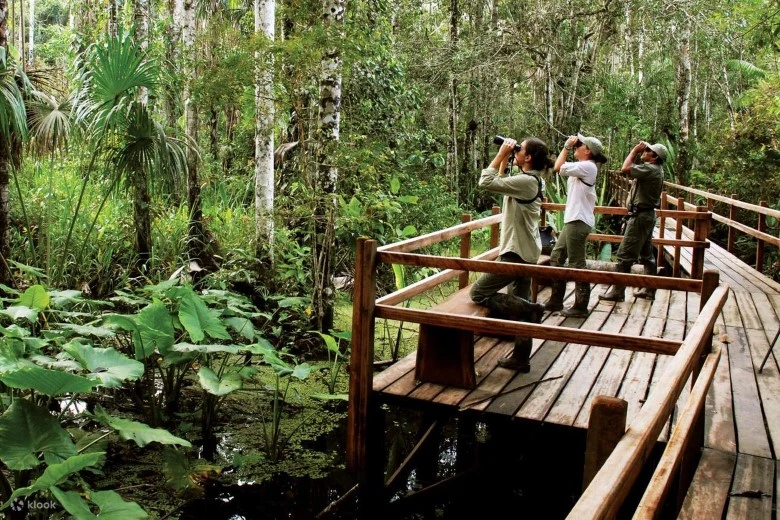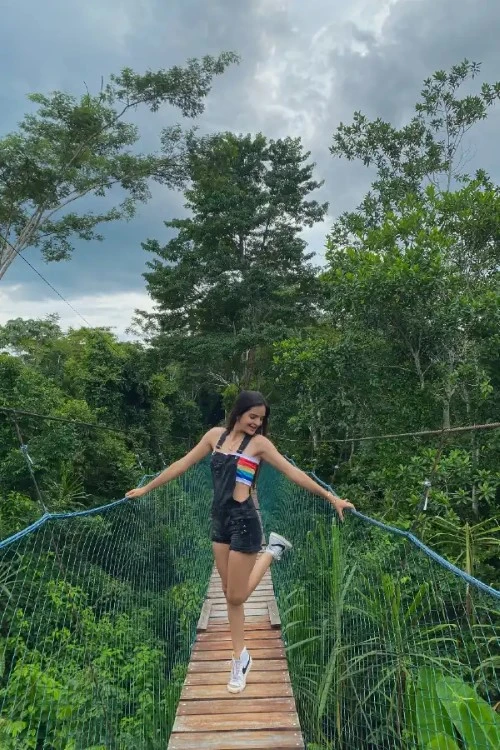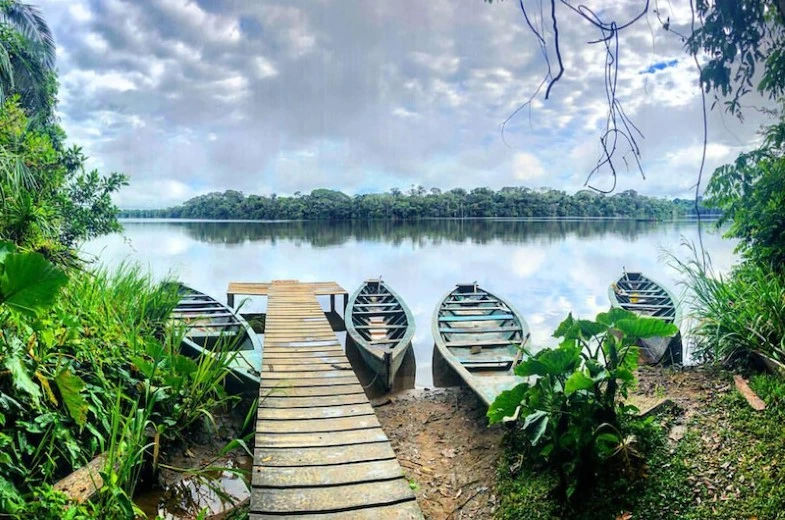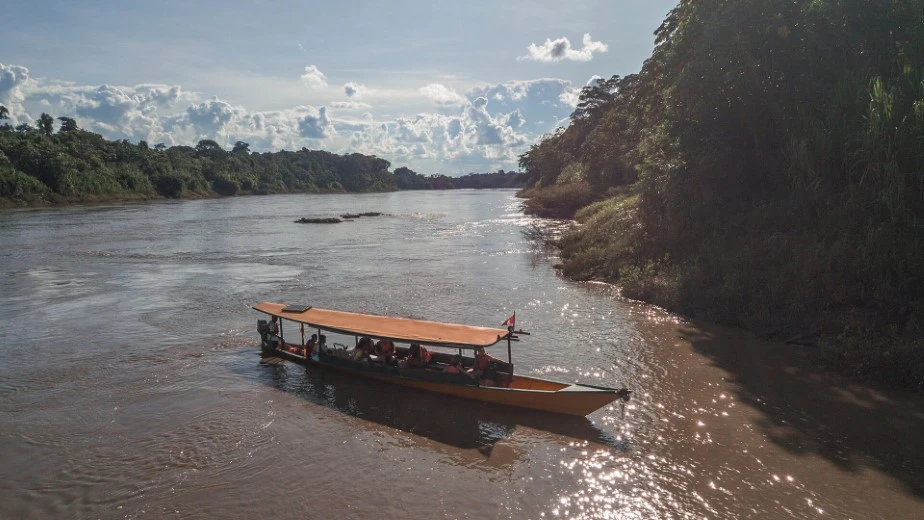Tambopata National Reserve in August offers warm and dry weather, ideal for a wildlife photography trip. In this month, Tambopata is in the heart of the dry season, which means less rain and clearer skies. Daytime temperatures reach 30°C (86°F), while nighttime temperatures drop to around 20°C (68°F), with very low chance of rain.
In fact, August is usually the driest month of the year in Tambopata, with about 14 to 15 hours of sunlight per day. With such stable weather, animals gather around water sources and clay licks, making it easier to observe and photograph them. The reserve is home to approximately 600 bird species, including macaws, parrots, toucans, and eagles. Many professional photographers visit Tambopata in August to capture birds in flight, monkeys in the trees, and caimans in the rivers. Moreover, the bright and consistent light of the dry season enhances the forest’s colors.
Climate in Tambopata National Reserve in August
In August, Tambopata is in the middle of the dry season. The weather is warm and relatively dry: daytime temperatures average around 30°C (86°F), and nighttime temperatures about 20°C (68°F). Skies are usually clear for most of the day, with around 14–15 hours of sunlight. August is one of the driest months of the year: a typical day has only a 17% chance of rain, with about 5.6 mm of rainfall. In summary, the weather in Tambopata National Reserve in August is very stable and dry, making walks and excursions more comfortable. Trails and rivers are also more navigable.

Advantages of visiting the Tambopata National Reserve in August
Visiting Tambopata in August offers several benefits:
- Less rain. August falls within the dry season (April–October), with very low precipitation. This makes boat rides and hikes easier, with no muddy trails.
- Better wildlife sightings. With less rain, animals gather around lakes and rivers; clay licks are clearly visible for macaws. Thus, birdwatching in August is excellent, with abundant sightings of macaws, parrots, toucans, and tropical birds.
- Easier access to points of interest. Lower water levels make it easier to reach places like Lake Sandoval.
- Pleasant weather for ecotourism. Temperatures are not extreme and it cools off at night. Less humidity also means fewer mosquitoes than in the rainy season.
- High tourist season. In August, many operators such as Peru Jungle Trips offer complete packages. This ensures qualified guides, comfortable accommodations, and services ready for international visitors.

Disadvantages of visiting Tambopata National Reserve in August
Although August is ideal, there are a few points to consider:
- Crowds. As it’s peak ecotourism season, there may be more tourists, and accommodation and service prices are slightly higher.
- Heat and intense sun. It can get very hot during the day, so it’s important to stay hydrated and protect yourself from the sun.
- Visibility in rivers. Lower river flow can sometimes leave cloudier waters in oxbow lakes.
- Agency access required. Only guided access through authorized agencies is allowed. This is positive for safety, but it requires planning and booking in advance with recognized companies.
In general, the advantages of visiting Tambopata National Reserve in August far outweigh the disadvantages, thanks to the dry weather and abundant wildlife.
Activities to do in Tambopata National Reserve in August
Tambopata’s biodiversity offers many experiences in August. Key activities include:
- Jungle hikes: observation of medicinal plants and century-old trees
- Observation towers: spotting exotic birds
- Night excursions: searching for nocturnal wildlife and observing the Milky Way
- Boat rides on the Tambopata River: chances to see jaguars, anacondas, and capybaras
- Chuncho clay lick: macaw and parrot watching, with camp-style breakfast
- Navigation through Tambopata River tributaries: spotting tapirs, wild boars, monkeys, and caimans
- Lake Yacumama: paddle boat rides, birdwatching, sightings of otters, caimans, and piranha fishing
- Lake Sandoval: wooden trail hike and boat rides to spot otters, caimans, herons, monkeys, and birds
- Hike to Lake Sandoval: 1.5 hours on foot and 45 minutes by boat from Puerto Maldonado
- Matsigenka cultural exchange: learning archery, weaving, making cushmas and ropes, and fire-starting techniques
- Night hikes: searching for porcupines, opossums, owls, spiders, and more
- Giant tree hike: exploration of flora and fauna in the canopy layer
- Hanging bridges: spotting toucans, hummingbirds, orchids, and monkeys
- Monkey Island: observing hybrid species, sloths, and turtles
- Night river trip on the Madre de Dios River: spotting caimans, owls, and capybaras
- La Cachuela clay lick: sunrise birdwatching with parrots, toucans, and sloths
- Sport fishing on the river: catching catfish, cichlids, and freshwater stingrays
- Relaxing in hammocks: rest surrounded by Amazon nature
In summary, there are many adventure activities in Tambopata National Reserve in August, from birdwatching to hikes, boat rides, and cultural experiences.

What to take to Tambopata National Reserve in August
When planning your trip to Tambopata National Reserve in August, consider bringing:
- Light, breathable clothing, preferably long-sleeved to protect from sun and mosquitoes
- Hat, sunglasses, and sunscreen
- Trekking boots or durable closed shoes
- Light backpack, basic first aid kit, and insect repellent
- Binoculars or camera, reusable water bottle, and headlamp
- Personal documents (passport, travel insurance)
- Flight and tour reservations. August is high season, so plan in advance
With these items, your jungle adventure in Tambopata National Reserve in August will be comfortable, safe, and more enjoyable.
Frequently Asked Questions about Tambopata National Reserve in August

1. Is it necessary to hire a guide to visit Tambopata National Reserve?
Yes, it is recommended to hire tour operators or local guides, as they are familiar with the area, safe routes, and the best spots for wildlife watching. In addition, their presence ensures a safe, educational, and environmentally respectful experience. Having a guide also helps you better understand the area’s biodiversity and minimize your environmental impact.
2. Is it safe to visit Tambopata National Reserve in August?
Yes, August is considered one of the safest and most recommended months to visit Tambopata National Reserve, as the weather conditions are generally dry and stable, making hikes, excursions, and wildlife spotting easier. During this time, there is less rain, the trails are more accessible, and mosquito presence decreases, improving the overall experience and reducing health or climate-related risks.
3. Is it possible to see jaguars in Tambopata National Reserve?
Although jaguar sightings are rare due to their elusive nature and nocturnal habits, Tambopata National Reserve is one of the few places in Peru where these big cats live freely in the wild. With patience, guided tours, and a bit of luck, visitors may be able to spot them in their natural and protected habitat.
4. What animal species can be seen in Tambopata National Reserve?
In addition to jaguars, visitors to Tambopata National Reserve can see a wide variety of species, such as monkeys, giant otters, caimans, macaws, parrots, tapirs, sloths, river dolphins, and many others, thanks to the area’s remarkable biodiversity.
5. Do I need to get vaccinated before visiting Tambopata National Reserve?
Yes, it is advisable to check with a health center about the recommended vaccines, such as yellow fever, before traveling to Amazonian regions.
6. Can Tambopata National Reserve be visited year-round?
Yes, the reserve is open all year, but the dry season (May to October) is the most recommended for tourist activities.

In August, Tambopata National Reserve has a warm and dry climate, with average temperatures around 86°F (30°C) during the day and 68°F (20°C) at night. With almost no rain and dry trails, it’s ideal for activities such as birdwatching, hiking, boat tours, visits to clay licks, and cultural tours. Book now with Peru Jungle Trips, we have expert local guides. August is definitely one of the best months to visit Tambopata National Reserve.
Tours to Tambopata National Reserve
- Lake Sandoval (2 Days)
- Tambopata Jungle Tour (3 Days)
- Sandoval Lake + Parrot clay lick + Native Community (4 days)
- Collpa Chuncho Macaw Clay Lick + Sandoval Lake & Yacumama Lake (4 Days)
Explore Tambopata National Reserve in July: Advantages and key travel tips for this month.
➜ Tambopata National Reserve in June: Weather, Pros and Cons
Learn everything about what Tambopata National Reserve is like in September
➜ Tambopata National Reserve in September: Weather, Pros and Cons

